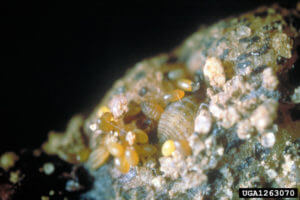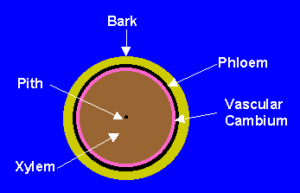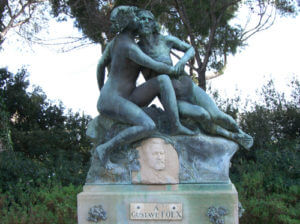Mary Shelley’s 1818 novel Frankenstein tells the story of a student named Viktor Frankenstein who performs a scandalous experiment – so scandalous that he keeps the knowledge of it from his closest family and friends. Broken, repentant, and emaciated at the end of the story, he pours out the tale of his hubris to a stranger. He has discovered the secret of life, he confesses; obsessed with
experiments in ‘natural philosophy’, he has been able to fashion a live human from body parts scrounged from graveyards and slaughterhouses.
 The resulting demon’s arms are like those of a mummy; his lips are black and dry; his eyes are yellow. Everyone that looks at him, including his creator, turns from him in utter revulsion. Not even given the dignity of a name, his creator refers to him as the fiend or the wretch. As a sutured set of body parts lying on a gurney he was merely grotesque, but when he moves, makes sounds, becomes animated – this is horrifying. He is not whole. No matter that he can speak or move or think, his origin is not natural. He is an unholy mishmash.
The resulting demon’s arms are like those of a mummy; his lips are black and dry; his eyes are yellow. Everyone that looks at him, including his creator, turns from him in utter revulsion. Not even given the dignity of a name, his creator refers to him as the fiend or the wretch. As a sutured set of body parts lying on a gurney he was merely grotesque, but when he moves, makes sounds, becomes animated – this is horrifying. He is not whole. No matter that he can speak or move or think, his origin is not natural. He is an unholy mishmash.
Soul of a tomato
Startlingly, the language and pictures used by GMO critics play directly on language used by Viktor Frankenstein to berate himself.
Some of the first battles over genetically modified foods involved the tomato, and claims that a  tomato had been engineered with “fish genes”. But there are no foods on the market that have been modified by animal genes–that’s a myth that’s grown into a staple criticism by GM opponents.
tomato had been engineered with “fish genes”. But there are no foods on the market that have been modified by animal genes–that’s a myth that’s grown into a staple criticism by GM opponents.
For example, Michael W. Fox, Vice President of the Humane Society, in Superpigs and Wondercorn, said genetically modified tomatoes were neither whole nor natural. And activist Jeremy Rifkin challenged the ethics of the precise transference of single genes in a way that he never would about other agricultural technologies that involve laboratory-based scrambling of genes, such as mutagenesis, which has been used to create thousands of organic foods and ingredients. Prince Charles wrote a deeply felt article in the UK Daily Telegraph claiming that the realm of gene transfer belonged to God and God alone.
In 1992, a professor of English at Boston College named Paul Lewis coined the portmanteau ‘Frankenfood’ to refer to GMOs.
“If they want to sell us Frankenfood,” he wrote in a letter to the New York Times in response an op-ed that called into question the safety of genetically modified tomatoes, “perhaps it’s time to gather the villagers, light some torches and head to the castle.”
The moniker took off. Pretty soon Jeremy Rifkin was organizing protests with Frankenfood cartoons on placards, and Greenpeace diversified into other ‘Franken’ characters such as FrankenTony the Tiger. ‘Fish-tomato’ graphics were plastered everywhere, some showing a tomato with fins, or, with fish-eyes staring at you from a plate.
But wait. The Flavr Savr tomato – the first genetically engineered food on grocery shelves that set off all this kerfuffle – could not even be characterized as a Frankenfood. It had an introduced copy of one of its own genes, but as a copy-in-reverse, in order to turn off production of an enzyme that causes cell-wall softening by dissolving pectin. By blocking this enzyme the tomato could stay firm longer on shelves. If an analogy is to be made, this is more like a skin graft surgery from one part of the body to another, than say, transplanting a pig heart into a human recipient. Unfortunately, the tomato they used to introduce this innovation wasn’t a very tasty variety, and the fruit flopped with consumers, who seemed at first to be willing to give the curiosity a try.
So where did the fish-tomato caricatures come from? This was a different product entirely, the result of an experiment performed by DNA Plant Technology, that used a gene from the winter flounder that retards freezing to make a frost-tolerant tomato. This tomato never left the labs. But it was this one that became a rallying point for opponents of genetic engineering. A tomato crossed with a fish? Yuck!
That is instructive. What it tells you is that while there were a number of reasonable critiques of the science and politics surrounding GMO foods, what really got people’s goat was the mixing of genes from different species. Jurassic Park had recently been released. It featured a genetic experiment gone awry, where some DNA from frogs is inserted into dinosaur sequences, which allows them to change their sex (like bullfrogs) and breed. Paranoia surrounding this type of radical miscegenation was in the air.
Life as a oneness
I don’t get this fear, but many do. I have tried to understand it; the closest I can come to it is to suggest that people take a soul-based view of living things and do not like to think of them as composed of building blocks. They fear absurd color-by-numbers butchery. In recent times DNA has become a stand-in for this elusive soul and people fear the ripping apart of this soul into bits. It is a form of essentialism.
But genetic engineering is not the first time humans have built living things out of parts. We have been doing so for thousands of years, sometimes with great success. Not necessarily on the level of genes, but rather, with the living bodies of plants.
But, just like genetic engineering, each time these technique have been proposed, they have caused some initial Fear, Uncertainty and Doubt.
Soul of wine
Wine is spoken of as though it has a personality that does not take kindly to deconstruction. The French have a word for this – terroir, which is the unique stamp that the land, the climate, and the microbes in the air put on the final product. Imagine being forced to perform the crudest kind of color-by-numbers surgery on a grape vine.
 In the 1860’s French grape growers around the Rhone Valley discovered a strange malady infecting their vineyards. The afflicted leaves turned yellow as though struck by an early autumn. The grapes shriveled and were unusable. As described in the book The Botanist and the Vintner by Christy Campbell, over the next decade the malady spread to nearly all the wine-growing regions of France. The crisis almost destroyed the wine industry and led to an exodus of small farmers from farms into urban areas.
In the 1860’s French grape growers around the Rhone Valley discovered a strange malady infecting their vineyards. The afflicted leaves turned yellow as though struck by an early autumn. The grapes shriveled and were unusable. As described in the book The Botanist and the Vintner by Christy Campbell, over the next decade the malady spread to nearly all the wine-growing regions of France. The crisis almost destroyed the wine industry and led to an exodus of small farmers from farms into urban areas.
Eventually (after some absorbing detective work described in the book) the culprit was found to be an aphid that settled on the roots and sucked on the sap, weakening and killing the plant. It had been imported on American grape vine cuttings that had crossed the Atlantic on steamships. On the Origin of Species by Charles Darwin had just come out; against that backdrop, scientists realized  that since the aphid Phylloxera had evolved in the American continent alongside American grapes, those species (Vitis riparia, V. rupestris) had evolved means to fight them back. The European vines (Vitis vinifera) were new to the aphids and had no defenses. They were sitting ducks.
that since the aphid Phylloxera had evolved in the American continent alongside American grapes, those species (Vitis riparia, V. rupestris) had evolved means to fight them back. The European vines (Vitis vinifera) were new to the aphids and had no defenses. They were sitting ducks.
Some proposed an ingenious solution that drew from an important principle in technology: do not reinvent the wheel. Allow the American grapevine roots to do what they do best – fight off Phylloxera. Allow the French ones to do what they do best – make good grapes for wine. Make a compound organism by grafting French grapevines onto American rootstocks. This would allow the famous grapes such as the Cabernets and the Pinot Noirs to continue to thrive, albeit on foreign legs.
Would it work? The French were not enamored of American wines, to put it mildly. They tasted odd and inferior, with an impossible-to-describe rankness that some characterized as the taste of ‘fox’. It was too much for some to embrace a solution that depended so heavily on these substandard foreigners, the culprits that caused the Phylloxera blight in the first place.
It was the Frankenfood fear of its day.
People worried about the desecration of centuries of French wine traditions. They worried about foxy notes from American grapes creeping into their wines. Then as now, there were proponents of the new science, but there were detractors. Botanist Jules Planchon was an early proponent of the grafting solution who had studied the lifecycle of the Phylloxera in great detail, and believed that salvation lay in the evolutionary secrets of the American rootstocks.
“The goût foxé will never pass in the least degree to the fruits of the vines grafted onto these foreign [wet nurses],” he wrote reassuringly.
Many others were not convinced. Then as now, some detractors were scientists. Lucien Daniel, a botanist, insisted that the rootstock did indeed modify the characters of the transplant and ultimately the wine. The grafted wines by no means had the constitution of the old wines, he wrote in the Times. Then as now, he advocated a return to tradition and nature. “There is only one way, have done with grafting; to restore them by returning to the deserted hillsides; to cultivate the vine once more in accordance with the methods and experience of centuries,” he wrote.
Sound familiar?
Grafting of plants
Would grafting work? Did the foxiness of the American grapes live in the grapes themselves, or was it in the American sap that would be circulating into the grafted French scion? Did the American vines suck up foxy-making nutrients from the ground?
If some believed the latter, they would not be much different from the ancient Greeks, who knew about grafting, but thought that each plant achieved its uniqueness from the ‘specific fluid’ it drew up from the ground. To make sense of grafting, they believed that the grafted scion sent roots down (through the rootstock) into the ground, in order to draw up its own specific fluid. Well, if this were so, American vines were certainly drawing in foxy-making fluid.
But that is not how grafting works – as a matter of fact, it is pretty much a true Frankenfood, because much like the monster created by Frankenstein, it is a compound organism with different DNA in each limb.
Plants have an incredible ability to regenerate organs. The hoariest trees put out new organs – leaves, shoots, roots – all the way into the last years of their lives. The only comparable ability in the animal kingdom is the ability of salamanders to grow new limbs or of some lizards to grow new tails.
We use this ability of plants every time we root a cutting to make a clone. We also use this ability while grafting. The top half of a plant, with its growing tips, is fused onto the bottom half of another. This is more than an uneasy partnership. The wood has actually fused together, the channels within have combined, and the two are now growing as one.
 What explains this ability that plants have, and we don’t? Stem cells.
What explains this ability that plants have, and we don’t? Stem cells.
A growing tip of stem cells produces the new shoot as the plant grows. Stem cells at growing root tips do the same underground. But another layer of stem cells along the woody trunk, one that is responsible for growing the plant in girth, is called the vascular cambium. This produces the fused boundary of grafted plants. The newly fused xylem takes water and nutrients from the foreign root system up to the leaves. While the newly fused phloem circulates nutrients down from the foreign leaf system.
In fact, if I might throw out a conjecture, the ‘secret of life’ discovered by Viktor Frankenstein might well have been stem cells.
A type of sex?
This is not much like mating at all. The fruit produced is not a hybrid. In fact, this is pretty much the opposite of sex, which happens through gametes (sperm and egg) containing scrambled half-genomes to give to the daughter cells; while stem cells differentiate into organs, the cells of which have exactly the same genome.
Even when grafting produces the rare so-called ‘graft hybrid’ or graft chimaera, what goes on internally is not mating. A famous chimaera is the Bizzaria orange. This is an orange grafted onto citron. At the graft boundary, it produces a curious fruit that looks like a citron fruit growing out of an orange. But this is due to mixing of cells within, each with a different genome, rather than the mixing of genomes.
But confusions between mating and grafting have bedeviled its history. Jewish religious prohibitions against mating different types of plants and animals were applied to grafting as well; the citron, which is used during Tabernacles, is not kosher if it comes from a grafted tree. The New Testament also uses grafting of olives as an analogy for breeding. The natural graft of mistletoe on oak is a fertility symbol from ancient times.
Humans have instinctive revulsion of the ‘wrong’ kind of mating; partners being too close in kinship, obviously; but also partners without a kinship at all (or a too distant one) arouse fears too. Perhaps it’s fears of becoming too wild; or falling out of cultivation? So it is not surprising that any hint of mating too far makes people scurry underground with their hands held over their ears.
The same fears have bedeviled our modern-day so-called Frankenfoods – genetically modified organisms (GMOs). Many commentators, even usually thoughtful ones, decry that GMOs “do not happen in nature”. Well, almost no food we eat today “happened” in nature. Some, such as Ruby Red grapefruits, were developed by mutagenesis – years of radiation and chemical dousing in a laboratory. I believe invoking Nature is just a code word, and what they really fear is unnatural sex.
So is genetic engineering a type of sex? Just like grafting, it is pretty much the opposite. The random scrambling of DNA is the essence of sex. There is nothing random about the careful choice of a single gene and the splicing into a different genome.
Now when you think of scrambling, prohibitions against too-distant kinship make sense. Just as you would get gibberish if you scrambled two texts together even if they were both written in the same language, results of mating distant creatures are rarely viable. But if you instead took a well-chosen word out of one text to put into a well-chosen spot in the other, it could work. Its very precision and intentionality makes this a different ballgame.
A single word in a book is not imbued with the essence of the book – it is merely English. Similarly, the gene from the winter flounder that makes antifreeze is not imbued with the essence of fishiness. It is merely written in the DNA language of A, C, G and T.
When grafting was controversial
In the Botany of Desire, foodie writer Michael Pollan recounts the story of Johnny Appleseed, the frontier hero who introduced apple trees across many of the states then being settled. Famously, Johnny Appleseed was against grafting. But in order to make sweet, edible apples one needs to grow the exact cultivar by cloning as grafts on rootstocks. If, instead, you grow them from seed, you get the result of apple flowers mating in the wild in their merry way – a heterogeneous crop of crab apples. This was the crop that Johnny Appleseed got – not much good for eating but good for drinking as hard cider.
What did he have against grafting? An early article published in Harper’s Monthly by W.D. Haley claims that Johnny Appleseed denounced grafting as absolute wickedness because it cut up the tree. A later historian claimed he believed that only God could improve the apple. But the grafting of apples was a new technology at the time and its adoption was not seamless.
On the one side were agricultural reformers, the vanguard, who promoted grafting as a means to have farmers make more profit from a uniform crop; on the other – were an assortment of doubters.
Some were simply smaller farmers, who could not afford the expensive apple grafts, nor did they have access to a good road system that could bring them. They mostly grew apples for their own consumption as fruit and cider, and in that way, were satisfied with the random crop from seedlings. Some gave in to superstition against cutting up the tree, much like, apparently, Johnny Appleseed. Then there were the ‘scientific’ theories of Thomas Andrew Knight and Jean-Baptiste Van Mons that spoke of grafts losing vigor over generations, that turned out to not be based on sound science.
But the most eloquent defense of the random crop of seedling apples came from Thoreau. In Wild Apples, he made a very modern argument against grafted apples – that of biodiversity.
“It takes a savage or wild taste to appreciate a wild fruit,” he says, counting himself among the wild ones. Then he went on to appreciate the homegrown beauty of the wild apples; their gnarly, crabbed appearance, stained with red streaks and rusty blotches. Some have called this attitude of Thoreau’s a reverse snobbery, and of course, it is very much that. In his Ivy League philosopher’s life, he could not appreciate the need for a farmer to grow a predictable crop that would sell at a profit.
But I see his point! The wilderness is wonderful, and of course it is the engine of the mind-boggling diversity in apples, and in everything else. There is nothing comparable to the pleasure of running into a wild raspberry bush, for instance, and their flavor is nothing like the ones found on grocery shelves. Many of the more eloquent arguments against genetically modified foods are based on biodiversity as well.
But neither grafting nor genetically modified plants are the cause of monoculture. The cause is the need for a high-yield, predictable crop. If one is to do this for a living, this stuff matters.
So can we call a truce? The wilderness is nature’s technology, and farming is ours. While the wilderness is the wellspring of astonishing variety, our well-being does not enter into its calculations. It does not care about us one whit. But we do. We don’t all want to return to the wild and live by subsistence foraging. Can we steward the wilderness while promoting technology where it makes sense?
What changed
Now of course, grafting is not the least bit controversial (well maybe a little bit) and even the Permaculture Research Institute, a sustainable farming group that is strongly opposed to GMOS, has how-to pages on grafting. This despite the fact that graft cultivars share some of the same features that people complain about with genetic engineering – patents (check), lack of open pollination (check), tinkering with nature (check), focus on only a few genetic strains of plants, i.e. monoculture (check, this is true for all vegetative reproduction, not only grafts), more expensive inputs (check, because growing seedlings is essentially free).
So what has changed? In the case of the French wine blight, proponents showed that grafting made no difference to the taste of wine and was the only practical way to save the industry given the slow march of the Phylloxera, which continues today. In the case of grafted apples in America, the temperance movement’s war on seedling apples sped up the course of history. So, despite emotional resistance, either economic or external forces ultimately won.
In the case of Frankenstein’s monster though, there were no economic or external forces to save him. The irony of the book is that the only mistake Frankenstein made is to disavow his creation. Far from being a demon, his creation was articulate and possessed fine sensibilities. He read and discoursed on Milton’s Paradise Lost. He once saved a woman from drowning. He secretly shoveled snow and collected firewood to help a poor family. He had a deep capacity for love.
One might even call him a genetic miracle.
As for the undiscerning, pitchfork-throwing public–the one that Paul Lewis called upon in his letter? A certain Internet phrase comes to mind, a phrase that is so fitting that Mary Shelley might well have subtitled her book with it. Fear, Uncertainty, Doubt.
Aneela Mirchandani is a software engineer by profession, a writer and biology geek. She blogs about food at The Odd Pantry. Her work has appeared in Harpur Palate and The Indian P.E.N. You can follow @theoddpantry on Twitter or email her at [email protected]
Additional Resources:
- Frankenstein, Mary Wollstonecraft Shelley
- The Botanist and the Vintner, Christy Campbell
- The Botany of Desire, Michael Pollan
- Johnny Appleseed and the American orchard, William Kerrigan
- A History of Grafting
- Principles of Budding and Grafting































